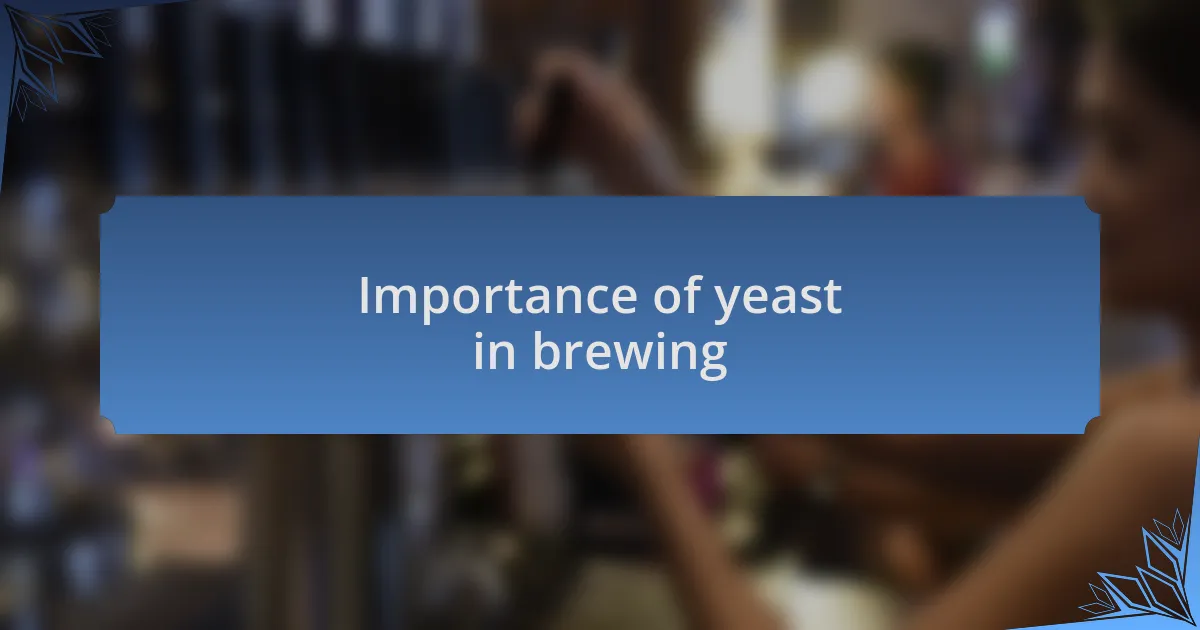Key takeaways:
- Craft beer festivals foster community and connection among brewers and attendees through shared appreciation for unique brews.
- Yeast is crucial in brewing, impacting fermentation, flavor, aroma, and overall beer quality.
- There are two main categories of beer yeast: ale yeast (Saccharomyces cerevisiae) and lager yeast (Saccharomyces pastorianus), each influencing beer differently based on fermentation temperature.
- Favorite yeast varieties can enhance different flavor profiles, with examples like American ale yeast, Belgian-style yeast, and wild yeast strains like brettanomyces adding complexity and uniqueness to the brewing experience.

Understanding craft beer festival
Craft beer festivals are vibrant gatherings that celebrate the artistry of brewing. I remember my first festival; the atmosphere buzzed with excitement, and the aromas of hops and malt beckoned me like an old friend. It’s incredible how a single event can bring together diverse brewers, each showcasing their unique creations.
As I wandered through the rows of booths, I pondered how craft beer festivals do more than just serve drinks; they create a community. Have you ever found yourself chatting with a stranger over a shared love for a rich stout or a hoppy IPA? These connections often lead to friendships rooted in a mutual appreciation for craftsmanship and creativity in brewing.
Attending a craft beer festival offers more than just sampling new flavors; it’s an opportunity to learn. I’ve had enlightening conversations with brewers, gaining insights into their processes and philosophies. Isn’t it fascinating how each sip reflects the passion, tradition, and innovation that goes into crafting a memorable brew?

Importance of yeast in brewing
Yeast is truly the unsung hero of brewing. Without it, there would be no fermentation, and no fermentation means no beer. I remember the first time I saw yeast in action during a homebrew session; watching those tiny organisms transform sugary liquid into frothy goodness was mesmerizing. It’s like witnessing magic unfold right before your eyes.
Beyond just creating alcohol, yeast imparts distinct flavors and aromas that define each beer’s character. For example, I once brewed a Belgian ale with a specific strain of yeast, and the spicy, fruity esters it produced added a delightful complexity. Have you ever considered how different yeast varieties contribute to the unique profiles of your favorite brews? It’s both fascinating and essential for brewers to select the right yeast to complement their vision.
Moreover, yeast plays a crucial role in the overall stability and quality of the beer. A healthy fermentation process can prevent unwanted flavors and spoilage, something I’ve learned the hard way after a few less successful batches. It’s astonishing how these microscopic organisms hold the key to creating not only delightful drinks but also a truly remarkable experience in each glass.

Overview of beer yeast varieties
There are primarily two main categories of beer yeast: ale yeast and lager yeast. Ale yeast, known scientifically as Saccharomyces cerevisiae, thrives at warmer temperatures and ferments quickly. I recall brewing a creamy stout with this yeast in mind, and the resulting rich, robust flavors opened my eyes to the versatility of ales. On the other hand, lager yeast, or Saccharomyces pastorianus, operates at cooler temperatures and typically takes longer to ferment, resulting in cleaner, crisper beers. Isn’t it remarkable how much temperature can influence the final taste?
Within these broad categories, numerous strains exist that impart unique characteristics to the beer. For instance, I once experimented with a specific Belgian strain that produced unforgettable fruity notes, much to the delight of my tasting crew. Similarly, some lager strains can enhance a beer’s mouthfeel and aroma profile. Have you ever considered the incredible variety that can arise from just swapping one yeast strain for another? The differences are sometimes subtle but can produce a substantial impact on your brew.
Beyond flavor, various yeast strains can also influence the beer’s aroma and even mouthfeel. I’ve tasted IPAs that were vibrant and aromatic due to the hops, but the yeast added an unexpected depth that left me pondering the brewing process. As I learned more about yeast, I realized how essential it is to consider the right strain for each style. It’s amazing to think that such a small organism can shape the entire beer experience, isn’t it?

My favorite yeast varieties
When it comes to my favorite yeast varieties, I can’t help but highlight the classic American ale yeast. This strain produces a clean, crisp finish that really lets the hop flavors shine. I remember brewing a refreshing pale ale with it, and the burst of citrus aroma felt like summer bottled up in a glass. Isn’t it incredible how a single ingredient can evoke such vivid memories?
Another yeast that has won my heart is the Belgian-style yeast. The complexity it brings is nothing short of magical. A few months ago, I crafted a tripel that showcased those stunning fruity and spicy notes, making the beer feel like an adventure with every sip. I find it fascinating how these yeast strains can transform a simple brew into a truly multi-dimensional experience. Have you ever sipped a beer and marveled at the layers of flavor that unfolded?
Finally, I have a soft spot for the earthy character imparted by some wild yeast strains, particularly brettanomyces. I recall tasting a sour ale that left me intrigued and a bit perplexed. The funky, barnyard notes paired perfectly with the sourness, creating an unforgettable profile that had me reaching for another pour. Isn’t it amazing how the wild side of yeast can challenge our perceptions of what beer can be?